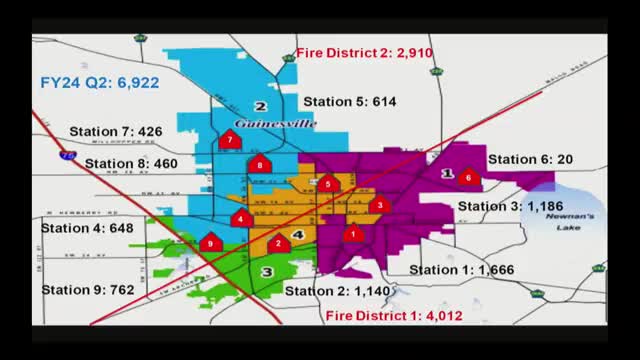Fire Department Faces Surge in Emergency Calls Amid Staffing Challenges
June 20, 2024 | Gainesville, Alachua County, Florida

This article was created by AI summarizing key points discussed. AI makes mistakes, so for full details and context, please refer to the video of the full meeting. Please report any errors so we can fix them. Report an error »

During a recent government meeting, officials discussed significant developments in emergency response metrics and staffing challenges within the city's fire department. The department reported a notable increase in call volume, with an average of nearly 30,000 calls annually, reflecting a rise from 27,782 responses last year. This uptick is attributed to various factors, including a higher frequency of emergency incidents, particularly during peak hours such as Thursdays around 1 PM and during lunch hours.
The fire department highlighted the complexity of their responses, noting that multiple units are often dispatched for a single incident, contributing to the total response count. Among the types of emergencies reported, lithium battery fires and hazardous spills have become more prevalent, necessitating swift action from emergency teams.
Officials also addressed the impact of urban density on response times. While turnout times—how quickly teams can leave the station after receiving a call—are meeting national standards, travel times have increased due to the growing population and traffic congestion. This trend raises concerns about the safety and efficiency of emergency responses, particularly in areas with new residential developments.
In response to these challenges, the department is actively collaborating with city planners to ensure that infrastructure changes accommodate emergency vehicles. Discussions included the need for improved road designs and traffic management to facilitate quicker access for emergency services.
Additionally, the meeting touched on staffing issues, with the department facing high attrition rates. Efforts are underway to recruit and retain personnel, particularly from underserved communities, aided by a grant from the Community Health Department. The department is also adapting to a younger workforce, emphasizing the importance of training and oversight to maintain service quality.
Budget discussions revealed that the department is currently operating below its overtime budget, which is a positive sign amid staffing challenges. Officials expressed optimism about maintaining operational efficiency as they navigate these ongoing issues.
The fire department highlighted the complexity of their responses, noting that multiple units are often dispatched for a single incident, contributing to the total response count. Among the types of emergencies reported, lithium battery fires and hazardous spills have become more prevalent, necessitating swift action from emergency teams.
Officials also addressed the impact of urban density on response times. While turnout times—how quickly teams can leave the station after receiving a call—are meeting national standards, travel times have increased due to the growing population and traffic congestion. This trend raises concerns about the safety and efficiency of emergency responses, particularly in areas with new residential developments.
In response to these challenges, the department is actively collaborating with city planners to ensure that infrastructure changes accommodate emergency vehicles. Discussions included the need for improved road designs and traffic management to facilitate quicker access for emergency services.
Additionally, the meeting touched on staffing issues, with the department facing high attrition rates. Efforts are underway to recruit and retain personnel, particularly from underserved communities, aided by a grant from the Community Health Department. The department is also adapting to a younger workforce, emphasizing the importance of training and oversight to maintain service quality.
Budget discussions revealed that the department is currently operating below its overtime budget, which is a positive sign amid staffing challenges. Officials expressed optimism about maintaining operational efficiency as they navigate these ongoing issues.
View full meeting
This article is based on a recent meeting—watch the full video and explore the complete transcript for deeper insights into the discussion.
View full meeting